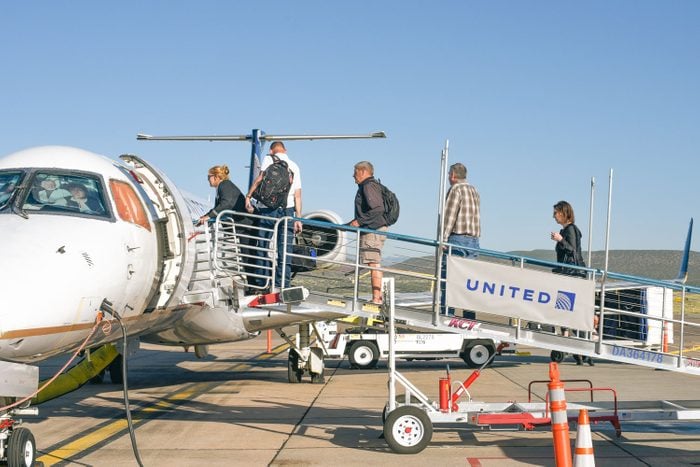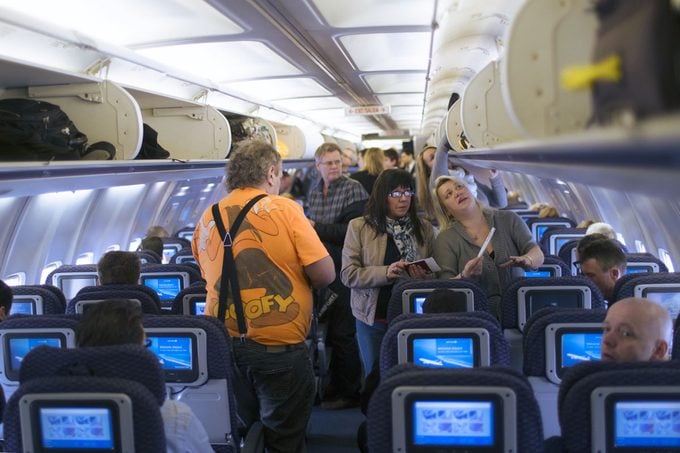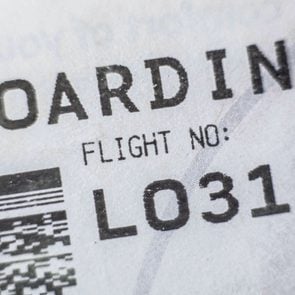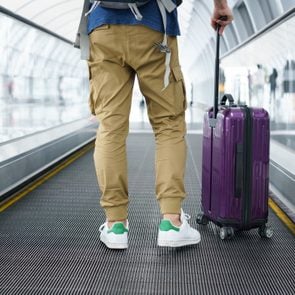United Airlines Is Changing Its Boarding Process—Here’s How It Will Affect You
Updated: Oct. 31, 2023

The United Airlines boarding process is getting a makeover. Here's what you need to know.
We’ve all been there: You’re waiting in line on the jet bridge to board your airplane, and time seems to be standing still. The process of boarding on a plane can feel painfully slow, to say the least, and more often than not, it’s unnecessarily so.
If you’re a seasoned traveler, then you know that most airlines have a similar boarding process, generally starting with first class, business class and passengers with status, followed by zone- or group-based boarding from back to front. Surprisingly though, this common practice isn’t the most efficient method. Which is why United Airlines is shaking things up. Here’s what you need to know before you purchase your next flight.
Get Reader’s Digest’s Read Up newsletter for travel tips, humor, cleaning, tech and fun facts all week long.
What is United Airlines’s new boarding process?
United Airlines has begun implementing a boarding method called WILMA, which boards window seats first, followed by middle seats and aisle seats last. Pre-boarding, priority and business-class passengers will still board first.
The new window-to-aisle boarding approach can shave up to two minutes off each flight’s boarding time, which equals about $200 in savings per flight for the airline, according to data from Airlines for America. And because United Airlines operates just shy of 5,000 flights daily, that can mean $1 million in savings per day.
These seemingly small improvements to boarding times are not only money saving, but they have the potential to significantly reduce the occurrence of ground delays, making flying an all-around better experience for United customers.
Why is this the most efficient way to board?
In recent years, several studies have been conducted to find the most timesaving way to board an airplane. The WILMA, or outside-in strategy, is faster than the traditional back-to-front strategy for two key reasons. Not only do passengers not have to ask each other to move, allowing them space to get into their seats, but they are all seated in different rows, meaning they aren’t vying for the same overhead space at the same time. While back-to-front boarding may be easier in theory, it always culminates in a bottleneck on the jet bridge as passengers step over each other trying to get to their seats and stow their bags.
Who will see changes to their boarding process?

Even though United Airlines is out with the old and in with the new, the boarding process isn’t changing entirely. You can still expect the pre-boarding process for people with disabilities, families with small children, unaccompanied minors and active-duty military personnel to remain intact. People seated in first class, business class and exit-row seats, as well as those with window seats—typically those in boarding groups one through three—will likely experience no change either. However, economy passengers with middle and aisle seats will board in groups four and five, with a new boarding group six reserved for those without a group number on their boarding pass. Considerations will also be made for people who book their tickets together, such as couples, families and other groups.
Other timesaving boarding methods
United isn’t the only airline to challenge the boarding on a plane status quo. Southwest Airlines and European carrier Ryanair use a random seating strategy that is generally considered the most efficient. Passengers line up at the gate and are free to choose whichever seat they like once the doors open.
Reverse pyramid is another boarding strategy, developed by the former America West Airlines and Arizona State University, that combines the WILMA and back-to-front methods. Passengers with back window seats board first, then passengers with window seats in the center and the front, followed by middle seats, then aisle seats, in the same order.
Some airlines opt to board their aircraft in zones, a method called block boarding, that alternates between zones in the front, back and center of the plane. A far less common—and less practical—boarding method is the Steffen Boarding strategy, developed by astrophysicist Jason Steffen, in which each passenger is individually called to board. This process is incredibly effective in theory, but is labor-heavy for gate agents in reality, not to mention unpopular among families who would prefer not to be separated.
No matter what order you board your next flight, what matters most is that you’re following airplane safety guidelines, stowing your carry-on luggage safely, your seat is in the fully upright position and for comfort’s sake, you’re wearing the right clothes.
Sources:
- Assaia: “Turnaround Benchmark Report”
- Airlines for America: “U.S. Passenger Carrier Delay Costs”



